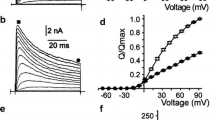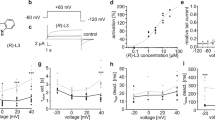Abstract
KV3.1 blockers can serve as modulators of the rate of action potential firing in neurons with high rates of firing such as those of the auditory system. We studied the effects of several bioisosteres of N-alkylbenzenesulfonamides, and molecules derived from sulfanilic acid on KV3.1 channels, heterologously expressed in L-929 cells, using the whole-cell patch-clamp technique. Only the N-alkyl-benzenesulfonamides acted as open-channel blockers on KV3.1, while molecules analogous to PABA (p-aminobenzoic acid) and derived from sulfanilic acids did not block the channel. The IC50 of six N-alkyl-benzenesulfonamides ranged from 9 to 55 µM; and the Hill coefficient suggests the binding of two molecules to block KV3.1. Also, the effects of all molecules on KV3.1 were fully reversible. We look for similar features amongst the molecules that effectively blocked the channel and used them to model a blocker prototype. We found that bulkier groups and amino-lactams decreased the effectiveness of the blockage, while the presence of NO2 increased the effectiveness of the blockage. Thus, we propose N-alkylbenzenesulfonamides as a new class of KV3.1 channel blockers.






Similar content being viewed by others
References
Aliot E, Capucci A, Crijns HJ, Goette A, Tamargo J (2011) Twenty-five years in the making: flecainide is safe and effective for the management of atrial fibrillation. Europace 13:161–173
Andalib P, Consiglio JF, Trapani JG, Korn SJ (2004) The external TEA binding site and C-type inactivation in voltage-gated potassium channels. Biophys J 87:3148–3161
Armstrong CM (1969) Inactivation of the potassium conductance and related phenomena caused by quaternary ammonium ion injection in squid axons. J Gen Physiol 54:553–575
Bassetto Junior CAZ, Varanda WA, González ERP (2017). 4-Chloro-3-nitro-N-butylbenzenesulfonamide acts on KV3.1 channels by an open-channel blocker mechanism. Amino Acids 49:1895–1906
Betz UA, Fischer R, Kleymann G, Hendrix M, Rübsamen-Waigmann H (2002) Potent in vivo antiviral activity of the herpes simplex virus primase helicase inhibitor BAY 57-1293. Antimicrob Agents Chem 46:1766–1772
Choi KL, Mossman C, Aubé J, Yellen G (1993) The internal quaternary ammonium receptor site of shaker potassium channels. Neuron 10:533–541
Choi BH, Choi J-S, Yoon SH, Rhie D-J, Min DS, Jo Y-H, Kim M-S, Hahn SJ (2001) Effects of norfluoxetine, the major metabolite of fluoxetine, on the cloned neuronal potassium channel Kv3.1. Neuropharmacology 41:443–453
Gan L, Kaczmarek LK (1998) When, where, and how much? Expression of the Kv3.1 potassium channel in high-frequency firing neurons. J Neurobiol 37:69–79
Gonçalves RS, Abdelnur PV, Santos VG, Simas RC, Eberlin MN, Magalhães A, Pérez González ER (2011) Synthesis of potentially bioactive PABA-related N-(aminoalkyl)lactamic amino acids and esters via selective SNAr reactions. Amino Acids 40:197–204
Grissmer S, Ghanshani S, Dethlefs B, McPherson JD, Wasmuth JJ, Gutman GA, Cahalan MD, and Chandy KG (1992) The Shaw-Related Potassium Channel Gene, Kv3.1, on Human Chromosome-11, Encodes the Type-L K+ Channel in T-Cells. J Biol Chem 267:20971–20979
Grissmer S, Nguyen AN, Aiyar J, Hanson DC, Mather RJ, Gutman GA, Karmilowicz MJ, Auperin DD, Chandy KG (1994) Pharmacological characterization of five cloned voltage-gated K+ channels, types Kv1.1, 1.2, 1.3, 1.5, and 3.1, stably expressed in mammalian cell lines. Mol Pharmacol 45:1227–1234
Gross MF, Beaudoin S, McNaughton-Smith G, Amato GS, Castle NA, Huang C, Zou A, Yu W (2007) Aryl sulfonamido indane inhibitors of the Kv1.5 ion channel. Bioorg Med Chem Lett 17:2849–2853
Gross MF, Castle NA, Zou A, Wickenden AD, Yu W, Spear KL (2009) Aryl sulfonamido tetralin inhibitors of the Kv1.5 ion channel. Bioorg Med Chem Lett 19:3063–3066
Hamill OP, Marty A, Neher E, Sakmann B, Sigworth FJ (1981) Improved patch-clamp techniques for high resolution current recording from cells and cell-free membrane patches. Pflugers Arch 391:85–100
Kim SE, Ahn HS, Choi BH, Jang H-J, Kim M-J, Rhie D-J, Yoon S-H, Jo Y-H, Kim M-S, Sung K-W, Hahn SJ (2007) Open channel block of A-type, Kv4.3, and delayed rectifier K + channels, Kv1.3 and Kv3.1, by sibutramine. J Pharmacol Exp Ther 321:753–762
Kluczyk A, Popek T, Kiyota T, de Macedo P, Stefanowicz P, Lazar C, Konishi Y (2002) Drug evolution: p-aminobenzoic acid as a building block. Curr Med Chem 9:1871–1892
Li W, Kaczmarek LK, Perney TM (2001) Localization of two high-threshold potassium channel subunits in the rat central auditory system. J Comp Neurol 437(2):196–218
Lien C-C, Jonas P (2003) Kv3 potassium conductance is necessary and kinetically optimized for high-frequency action potential generation in hippocampal interneurons. J Neurosci 23:2058–2068
Lloyd J, Atwal KS, Finlay HJ, Nyman M, Huynh T, Bhandaru R, Kover A, Schmidt J, Vaccaro W, Conder ML, Jenkins-West T, Levesque P (2007) Benzopyran sulfonamides as Kv1.5 potassium channel blockers. Bioorg Med Chem Lett 17:3271–3275
Martins CC (2015) Síntese de N-Alquilsulfonamidas análogos do PABA com potencial atividade antagonista de canais iônicos. Dissertation—São Paulo State University
Martins CC, Bassetto CAZ, Santos JM, Eberlin MN, Magalhães A, Varanda WA, Gonzalez ERP (2016) Mass spectrometry study of N-alkylbenzenesulfonamides with potential antagonist activity to potassium channels. Amino Acids 48:445–459
McCrossan ZA, Lewis A, Panaghie G, Jordan PN, Christini DJ, Lerner DJ, Abbott GW (2003) MinK-related peptide 2 modulates Kv2.1 and Kv3.1 potassium channels in mammalian brain. J Neurosci 23:8077–8091
Olsson RI, Jacobson I, Iliefski T, Boström J, Davidsson Ö, Fjellström O, Björe A, Olsson C, Sundell J, Gran U, Gyll J, Malmberg J, Hidestål O, Emtenäs H, Svensson T, Yuan Z-Q, Strandlund G, Åstrand A, Lindhardt E, Linhardt G, Forsström E, Högberg Å, Persson F, Andersson B, Rönnborg A, Löfberg B (2014) Lactam sulfonamides as potent inhibitors of the Kv1.5 potassium ion channel. Bioorg Med Chem Lett 24:1269–1273
Ozawa Y, Sugi NH, Nagasu T, Owa T, Watanabe T, Koyanagi N, Yoshino H, Kitoh K, Yoshimatsu K (2001) E7070, a novel sulphonamide agent with potent antitumour activity in vitro and in vivo. Eur J Cancer 37:2275–2282
Ramos E, O’Leary ME (2004) State-dependent trapping of flecainide in the cardiac sodium channel. J Physiol 560:37–49
Snyders DJ, Knoth KM, Roberds SL, Tamkun MM (1992) Block by quinidine cloned human cardiac potassium channel. Mol Pharmacol 41:322–330
Sung MJ, Ahn HS, Hahn SJ, Choi BH (2008) Open channel block of Kv3.1 currents by fluoxetine. J Pharmacol Sci 106:38–45
Walter ME, Mora C, Mundstock K, de Souza MM, de Oliveira Pinheiro A, Yunes RA, Nunes RJ (2004) Antinociceptive properties of chloromaleinimides and their sulphonyl derivatives. Archivder Pharmazie 337:201–206
Wang L-Y, Gan L, Forsythe ID, Kaczmarek LK (1998) Contribution of the Kv3.1 potassium channel to high-frequency firing in mouse auditory neurons. J Physiol 509:183–194
Acknowledgements
We are thankful to MSc Carina Couto Martins for synthesis of benzenesulfonamide; to Dr. André Dagostin and Fernando Aguiar for technical assistance; to Dr George Chandy from the Department of Molecular Physiology at Lee Kong Chian School of Medicine, NTU (Nanyang Technological University, Singapore) for providing us the L-929 cells stably transfected with mouse KV3.1. This work was supported by Coordenação de Aperfeiçoamento de Pessoal de Nível Superior—CAPES (PhD fellowship—Carlos Alberto Zanutto Bassetto Jr.) and São Paulo State Research Foundation (FAPESP) for financial support to WAV (Grant #2012/19750-7) and ERPG (Grant #2013/24487-6).
Author information
Authors and Affiliations
Corresponding author
Ethics declarations
Conflict of interest
The authors declare that they have no conflicts of interest.
Research involving human participants and/or animals
This article does not contain any studies with human participants or animals performed by any of the authors.
Informed consent
This article does not contain any studies with human participants performed by any of the authors.
Additional information
Handling Editor: E. Closs.
Rights and permissions
About this article
Cite this article
Bassetto Junior, C.A.Z., Passianoto, L.V.G., González, E.R.P. et al. Benzenesulfonamides act as open-channel blockers on KV3.1 potassium channel. Amino Acids 51, 355–364 (2019). https://doi.org/10.1007/s00726-018-2669-5
Received:
Accepted:
Published:
Issue Date:
DOI: https://doi.org/10.1007/s00726-018-2669-5




